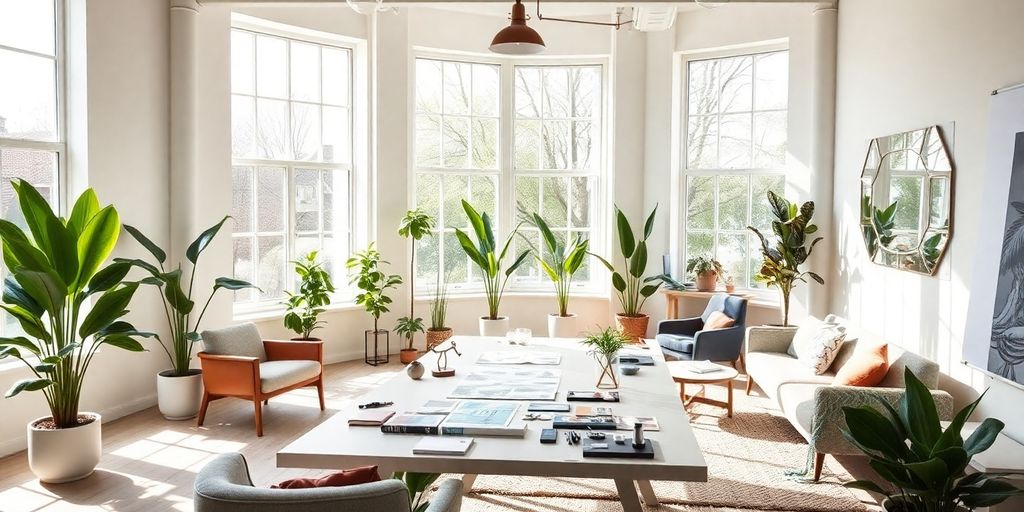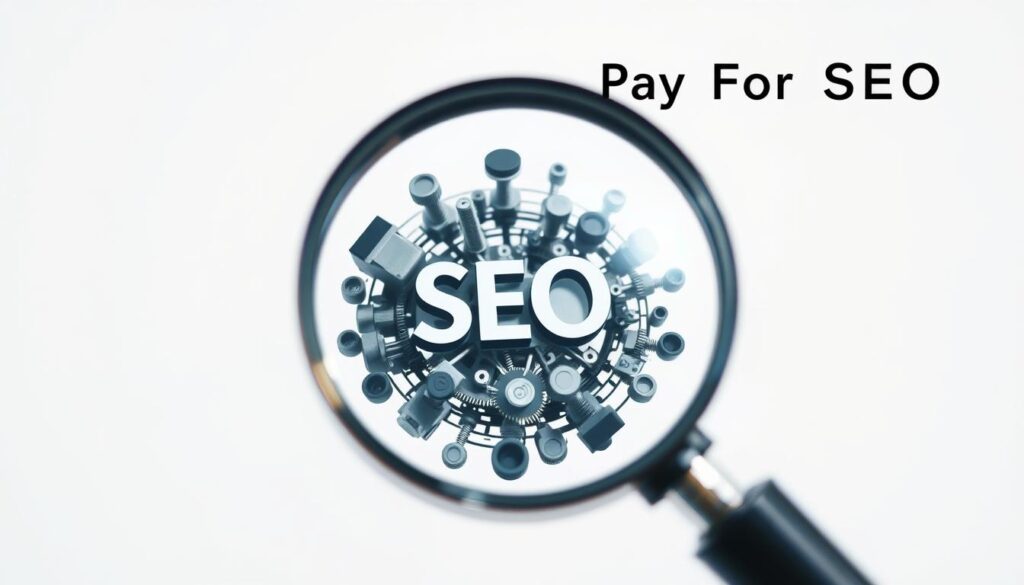Ever wondered how to get your interior design studio noticed online? It’s not just about having a stunning portfolio. You need to dive into the world of Search Engine Optimization (SEO). This guide breaks down SEO specifically for interior design studios. Whether you’re just starting out or looking to refine your strategy, understanding SEO can help your business shine in the crowded digital space. Let’s explore what makes SEO tick for designers and how you can use it to boost your online presence.
Key Takeaways
- SEO helps your design studio be more visible online, making it easier for clients to find you.
- Keyword research is crucial. Use specific terms that potential clients might search for.
- On-page SEO includes optimizing your homepage, headers, and images to improve search rankings.
- Content marketing, like blogging and social media, can drive traffic and enhance SEO.
- Technical SEO aspects, like site speed and mobile optimization, are vital for a good user experience.
Understanding SEO for Interior Design Studios

Defining Search Engine Optimization
SEO, or Search Engine Optimization, is all about making your website more visible on search engines like Google. It’s not just about adding a bunch of keywords to your site. It’s about understanding what people are searching for and making sure your site answers those questions. For interior design studios, this means showing up when someone searches for "modern living room ideas" or "best interior designers near me." The goal is to connect with potential clients by being the answer to their search queries.
Importance of SEO in Design
In the world of interior design, having a stunning portfolio is great, but if no one sees it, what’s the point? SEO helps bring eyes to your work. When your site ranks higher in search results, more people find you, and that can lead to more projects. Plus, good SEO practices can improve your site’s usability and user experience, making it easier for visitors to find what they need. This is crucial for turning visitors into clients.
Common Misconceptions About SEO
Many think SEO is a one-time task or that it’s all about tricking search engines. But that’s not true. SEO is an ongoing process that involves updating content, keeping up with algorithm changes, and ensuring your site is technically sound. Some believe that SEO is only about keywords, but it’s also about how fast your site loads, whether it’s mobile-friendly, and even how you structure your URLs.
SEO isn’t just for tech geeks; it’s a vital tool for interior designers who want to stay competitive in a digital world.
To effectively optimize your interior design website, you need to implement targeted SEO strategies that enhance online visibility and attract potential clients.
Keyword Research for Interior Designers

Identifying Relevant Keywords
Finding the right keywords is like setting the foundation for a building. You need to know what your potential clients are typing into search engines. Start by thinking about the services you offer and the unique aspects of your business. For instance, if you specialize in modern minimalist designs, that’s a keyword to consider. But don’t stop there. Think about location-based keywords too, like "interior designer in Austin." These often have higher search volumes. Choosing the right keywords can drive more quality traffic to your site.
Utilizing Long-Tail Keywords
Long-tail keywords might seem less exciting because they get fewer searches, but they’re gold mines. These are longer phrases that are more specific, like "eco-friendly interior design for small apartments." They might not bring in tons of visitors, but the ones they do attract are often ready to hire. So, mix these in with your broader keywords to capture a wider audience.
Tools for Keyword Research
You don’t have to do all this manually; there are tools to help. Here are a few to get you started:
- Google Keyword Planner: A solid tool for getting keyword ideas and search volumes.
- Ubersuggest: Offers insights into keyword suggestions and competition.
- Answer the Public: Great for finding questions people are asking related to your keywords.
Using the right tools can simplify your keyword research and help you focus on terms that will actually bring results.
Remember, keyword research isn’t a one-time task. It’s an ongoing process that evolves as your business and the market change. Keep refining your list and testing new keywords to stay ahead.
On-Page SEO Strategies
Optimizing Homepage Content
Your homepage is like your digital storefront. It’s the first impression visitors get, so make it count. Crafting engaging and informative content can significantly boost your SEO efforts. Start by clearly stating what your interior design studio offers. Use keywords naturally in your text. Avoid stuffing them in awkwardly just to rank higher—Google doesn’t like that. Instead, focus on what makes your studio unique. Maybe it’s your approach to sustainable design, or perhaps it’s your knack for blending styles. Highlight these points to make your homepage stand out.
Effective Use of Header Tags
Headers are more than just big, bold text—they’re crucial for SEO. Use them to structure your content logically. Start with an H1 tag for your main heading, then use H2s and H3s for subheadings. This hierarchy helps search engines understand your content better. Remember to include keywords in your headers, but don’t overdo it. Keep it natural and relevant.
Image Optimization Techniques
Images are vital in interior design, but they can slow down your site if not optimized. Use descriptive file names and alt text to help search engines "see" your images. For instance, instead of "IMG1234.jpg," try "modern-living-room-design.jpg." Compress your images to reduce load times without sacrificing quality. Fast-loading pages not only improve user experience but also boost your SEO ranking.
"In the world of interior design, a picture is worth a thousand words, but only if people can find it online."
By focusing on these on-page SEO strategies, you can improve your site’s visibility and attract more potential clients. Remember, it’s not just about getting people to your site—it’s about keeping them there with engaging, high-quality content.
Content Marketing for Interior Design
The Role of Blogging
Blogging is like having a conversation with your audience. It’s a way to share your insights and establish yourself as an expert in the field. Regular blog posts on topics like "Effective content marketing strategies for interior designers" can help your interior design studio rank higher in search results. Keeping the content fresh and relevant is key.
Blogging helps maintain a steady stream of visitors to your site, turning casual readers into potential clients.
When choosing topics, think about what your audience wants to know. Use a keyword research tool to find terms that are relevant to your niche. Once you have your keywords, check what’s already out there by looking at search results. This helps you create content that stands out.
Creating Engaging Visual Content
Interior design is a visual field, so your content should reflect that. High-quality images, videos, and even virtual tours can showcase your work effectively. Visual content not only engages your audience but also improves your SEO. Make sure to optimize images by using descriptive file names and alt tags.
- Use high-resolution images to highlight design details.
- Create video tutorials or walkthroughs of design projects.
- Consider virtual reality tours for an immersive experience.
Leveraging Social Media for SEO
Social media platforms are powerful tools for boosting your SEO. Sharing blog posts, images, and videos on platforms like Instagram and Pinterest can drive traffic to your website. Engage with your audience by responding to comments and participating in discussions. This interaction helps build a community around your brand.
- Post regularly to keep your audience engaged and informed.
- Use hashtags strategically to increase visibility.
- Collaborate with influencers to reach a broader audience.
By integrating these strategies into your content marketing plan, you can enhance your online presence and attract more clients to your interior design business.
Building Authority Through Backlinks
Understanding Backlinks
Backlinks are like votes of confidence from one website to another. They tell search engines your content is worth checking out. Think of them as endorsements from other sites. When a reputable site links to yours, it signals to search engines that your content is trustworthy and relevant. This can boost your site’s visibility and ranking.
Strategies for Acquiring Backlinks
- Guest Posting: Write articles for other blogs or websites. It’s a great way to share your expertise and include a link back to your site.
- Link Swapping: Reach out to non-competing businesses, like local furniture stores, and propose exchanging links. This can be a win-win for both parties.
- Digital PR: Engage in online publicity efforts. This might include getting featured in articles or podcasts, which can naturally lead to backlinks.
Building backlinks is not just about numbers, but about quality. A few strong links from authoritative sites can do wonders for your SEO.
The Importance of Local Listings
Local listings can significantly impact your SEO, especially for interior design studios focusing on a specific area. Ensure your business is listed on platforms like Google My Business. These listings often allow you to include links back to your website, enhancing your local SEO efforts.
Incorporating these strategies can help build a robust backlink profile, enhancing your site’s authority and visibility in search engine results. For those dedicated to enhancing their home environments, valuable opportunities for guest posts, link insertions, and sponsored content are available.
Technical SEO Considerations
Website Speed and Performance
When it comes to technical SEO, website speed is paramount. Slow-loading pages can frustrate users and lead to higher bounce rates, which isn’t great for your SEO. Use tools like Google PageSpeed Insights to check how fast your site loads and get tips on how to improve it. Here’s a quick checklist to boost your site’s speed:
- Minimize HTTP requests by reducing the number of elements on your page.
- Compress and optimize images to decrease file sizes.
- Enable browser caching to speed up load times for repeat visitors.
Mobile Optimization
With mobile searches on the rise, ensuring your website is mobile-friendly is non-negotiable. Google uses mobile-first indexing, which means it looks at the mobile version of your site first when determining rankings. So, how do you make sure your site is up to par?
- Use a responsive design that adjusts seamlessly to different screen sizes.
- Test your site on various devices to ensure a smooth user experience.
- Avoid using Flash, as it’s not supported on most mobile devices.
Structured Data and Schema Markup
Structured data helps search engines understand the content of your site better. By implementing schema markup, you can provide additional context about your pages, which can enhance how your listings appear in search results. Here’s why it’s beneficial:
- It can lead to rich snippets, which are more visually appealing and can improve click-through rates.
- Helps search engines index your site more effectively.
- Can improve your local SEO by providing clear information about your business location and services.
Remember, technical SEO is like the foundation of a house; it needs to be solid for everything else to work well. Investing time in these areas can significantly improve your site’s performance and visibility.
Measuring SEO Success
Key Metrics to Track
When it comes to figuring out if your SEO efforts are paying off, there are a few key metrics you should keep an eye on. First off, organic traffic is crucial. This tells you how many people are visiting your site thanks to search engines. Next, take a look at your bounce rate. This metric shows how many visitors leave your site after viewing just one page. A high bounce rate might mean your content isn’t engaging enough or relevant to what people are searching for. Finally, tracking your conversion rate is essential. This shows how many visitors are taking the desired action, like signing up for a newsletter or making a purchase.
Using Google Analytics
Google Analytics is a must-have tool for anyone serious about SEO. It gives you a detailed look at where your traffic is coming from and how users interact with your site. You can see which pages are the most popular, how long visitors stay on your site, and what paths they take through your content. Plus, it integrates with Google Search Console, giving you insights into how your site performs in search results.
Adjusting Strategies Based on Data
Once you’ve gathered enough data, it’s time to make some changes. If you notice certain keywords are driving a lot of traffic but not converting, it might be time to tweak your content to better match user intent. On the flip side, if some pages have a low bounce rate and high conversion rate, consider using them as a template for other content. Regularly reviewing and adjusting your strategies based on SEO metrics helps ensure your efforts are not just driving traffic but also bringing in qualified leads.
Wrapping It Up
So, there you have it. SEO for interior design studios isn’t some mystical art; it’s a practical tool you can use to get your work noticed. By focusing on the right keywords, optimizing your images, and maybe even starting a blog, you can make sure your studio stands out in search results. It’s all about making it easier for potential clients to find you when they’re looking for design help. Sure, it might take a bit of effort to get the hang of it, but once you do, the benefits can be huge. More visibility means more clients, and more clients mean more opportunities to do what you love. So, why not give it a shot? Your future clients are out there searching for you right now.
Frequently Asked Questions
What is SEO and why is it important for interior designers?
SEO, or Search Engine Optimization, is a way to make your website show up better in search results like Google. For interior designers, it’s important because it helps potential clients find your services online more easily.
How can I find the right keywords for my interior design business?
Start by thinking about words your clients might use to find your services. You can use tools like Google Keyword Planner to see what people are searching for. Focus on specific phrases, known as long-tail keywords, to attract the right audience.
What are some simple ways to improve my website’s SEO?
You can start by adding relevant keywords to your website’s text, using clear headers, and ensuring your site loads quickly. Also, make sure your site looks good on mobile devices and use alt text for images.
How does blogging help with SEO for interior design?
Blogging helps by providing fresh content that can attract visitors to your site. It also gives you a chance to use more keywords and show your expertise, which can improve your site’s ranking in search results.
Why are backlinks important for my website?
Backlinks are links from other websites to yours. They help build your site’s authority and trustworthiness, which can boost your search engine ranking. Getting links from reputable sites is especially beneficial.
What is local SEO and how can it help my design studio?
Local SEO focuses on making your business visible to people searching in your area. By using location-based keywords and setting up a Google My Business profile, you can attract more local clients.






